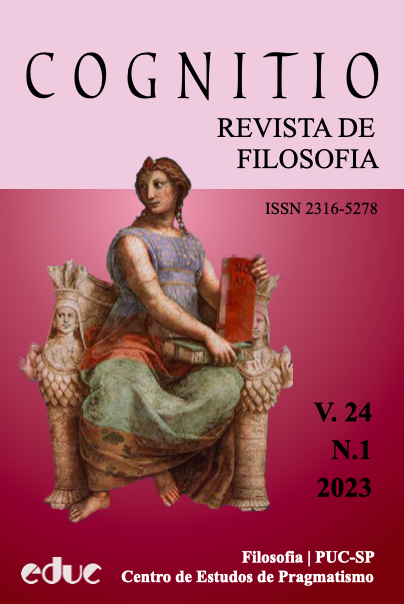Notas para uma semiótica da arte
belezas icônicas na poiesis cósmica
Resumo
Embora Charles Peirce raramente tenha aplicado seus princípios semióticos à arte, suas ideias são altamente informativas por contemplar a troca de significado qualitativo nos signos icônicos constitutivos da arte. Refletindo sobre a teoria do ícone de Peirce, três subtipos hipoicônicos, o papel formativo do signo-interpretante e a “qualissignificância” metafísica de um universo “permeado de signos”, forneço algumas notas teóricas para esboçar uma semiótica da arte. Mais ilustrativas de uma semiótica peirciana da arte são a pintura americana da Escola do Rio Hudson e a poesia moderna de Wallace Stevens, que avançam progressivamente suas percepções em seus próprios belos signos. Esses filósofos e artistas têm raízes intelectuais no transcendentalismo de Emerson com seu legado neoplatônico e, juntos, formam uma linha única de estética americana.
Referências
CARROLL, Joseph. Wallace Stevens’ supreme fiction: a new romanticism. Baton Rouge: Louisiana State University Press, 1987.
CRITCHLEY, Simon. Things merely are: philosophy in the poetry of Wallace Stevens. New York: Routledge, 2005.
DEWEY, John. Art as experience. New York: Minton, Balch & Co, 1934.
DILWORTH, David A. Transcendental naturalism and skeptical materialism: legacy paradigms in Emerson, Santayana, and Peirce. Cognitio: Revista de Filosofia, v. 23, n. 1, p. 1-35, 2022. [https://doi.org/10.23925/ 2316-5278.2022v23i1:e59920].
DILWORTH, David A. Santayana’s anti-romanticism versus Stevens’s new romanticism. Overheard in Se- ville: Bulletin of the Santayana Society, v. 35, p. 32-48, 2017. [https://doi.org/10.5840/santayana201735358].
DILWORTH, David A. The life of the spirit in Santayana, Stevens, and Williams. Overheard in Seville: Bul- letin of the Santayana Society, v. 23, p. 16-22, 2005. [https://doi.org/10.5840/200523234].
DURAND, Asher. Letter I, Letter IV, and Letter VII, Letters on landscape painting. The crayon, v. 1, n. 1; 7; 18, p. 1-2; 97-98; 273-275, 1855. [https://doi.org/10.2307/25526853].
EMERSON, Ralph Waldo. Beauty. In: EMERSON, Ralph Waldo. The conduct of life, v. 6, The Collected Works of Ralph Waldo Emerson. Cambridge: Harvard University Press, 2003, p. 149-163.
GUARDIANO, Nicholas L. Aesthetic transcendentalism in Emerson, Peirce, and nineteenth-century Ameri- can landscape painting. Lanham: Lexington Books, 2017a.
GUARDIANO, Nicholas L. Charles S. Peirce’s New England neighbors and embrace of transcendentalism. Transactions of the Charles S. Peirce Society, v. 53, n. 2, p. 216-245, 2017b. [https://doi.org/10.2979/tran- charpeirsoc.53.2.03].
GUARDIANO, Nicholas L. Metaphysical grounds of universal semiosis. Cognitio: Revista de Filosofia, v. 21, n. 2, p. 231-243, 2020. [https://doi.org/10.23925/2316-5278.2020v21i2p231-245].
GUARDIANO, Nicholas L. Transcendentalist encounters with a universe of signs. The American Journal of Semiotics, v. 37, n. 1-2, p. 5-45, 2021. [https://doi.org/10.5840/ajs202172772].
HEADE, Martin Johnson. Papers. Archives of American Art, Washington, D.C. 2007. https://www.aaa.si.edu/ collections/martin-johnson-heade-papers-7699
HOCUTT, Max Oliver. The logical foundations of Peirce’s aesthetics. Journal of Aesthetics and Art Criti- cism, v. 21, p. 157-166, 1962. [https://doi.org/10.1111/1540_6245.jaac21.2.0157].
INNIS, Robert. Dewey’s Peircean aesthetics. Cuadernos de Sistemática Peirceana, v. 6, p. 139-160, 2014.
JAPPY, Tony. Introduction. In: JAPPY, T. (Ed.). The Bloomsbury companion to contemporary
Peircean semiotics. London: Bloomsbury Academic, 2020. p. 1-29.
KANT, Immanuel. Critique of judgment. Trans. Werner S. Pluhar. Indianapolis: Hackett Publishing, 1987.
LEFEBVRE, Martin. Peirce’s esthetics: a taste for signs in art. Transactions of the Charles Peirce Society, v. 43, n. 2, p. 319-344, 2007. [https://doi.org/10.2979/TRA.2007.43.2.319].
LEVI, Albert William. Peirce and painting. Philosophy and Phenomenological Research, v. 23, n. 1, p. 23-36, 1962. [https://doi.org/10.2307/2104986].
MORRIS, Charles W. Esthetics and the theory of signs. Journal of Unified Science (Erkenntniss), v. 8, n. 1/3, p. 131-150, 1939. [https://doi.org/10.1007/BF00176021].
PEIRCE, Charles S. The essential Peirce: selected philosophical writings. HOUSER, Nathan; KLOESEL, Christian; Peirce Edition Project (Eds.). Bloomington: Indiana University Press, 1992; 1998. 2 vols. [Cited as EP followed by volume and page number].
PEIRCE, Charles S. Selected writings on semiotics, 1894–1912. BELLUCCI, Francesco (Ed.). Mouton: De Gruyter, 2020. [Cited as SWS followed by page number].
PEIRCE, Charles S. Prolegomena to an apology for pragmaticism. The Monist, v. 16, n. 4, p. 492-546, 1906. [https://doi.org/10.5840/monist190616436].
POLLOCK, Jackson. My painting. In: KARMEL, Pepe (Ed.). Jackson Pollock: interviews, articles, and re- views. New York: The Museum of Modern Art, 1999. p. 17-18.
POLLOCK, Jackson. Interview by William Wright, WERI, Rhode Island, 1950. In: KARMEL, Pepe (Ed.). Jackson Pollock: interviews, articles, and reviews. New York: The Museum of Modern Art, 1999. p. 20-23.
SANTAYANA, George. The sense of beauty: being the outline of aesthetic theory. New York:
Dover, 1955.
SHORT, T. L. Peirce’s theory of signs. Cambridge: Cambridge University Press, 2007.
SMITH, C. M. The aesthetics of Charles S. Peirce. Journal of Aesthetics and Art Criticism, v. 31, n. 1, p. 21- 29, 1972. [https://doi.org/10.2307/429607].
STEBBINS, Jr., Theodore E. The life and work of Martin Johnson Heade: a critical analysis and
catalogue raisonné. New Haven: Yale University Press, 2000.
STEVENS, Wallace. The collected poems of Wallace Stevens. New York: Vintage Books, 1990.
STEVENS, Wallace. Adagia. In: BATES, Milton J. (Ed.). Opus Posthumous. New York: Vintage Books, 1989. p. 184-202.
STEVENS, Wallace. Letters of Wallace Stevens. STEVENS, Holly (Ed.). Berkeley: University of California Press, 1966.
STEVENS, Wallace. Effects of Analogy. In: STEVENS, Wallace. The necessary angel: essays on reality and the imagination. New York: Vintage Books, 1951 (1948). p. 105-130.
TWAIN, Mark. Quoted in: NOVAK, Barbara. Voyages of the Self: Pairs, Parallels, and Patterns In American Art and Literature. New York: Oxford University Press, 2007. p. 62-63.
Downloads
Publicado
Edição
Seção
Licença
Copyright (c) 2023 http://creativecommons.org/licenses/by/4.0/

Este trabalho está licenciado sob uma licença Creative Commons Attribution 4.0 International License.



